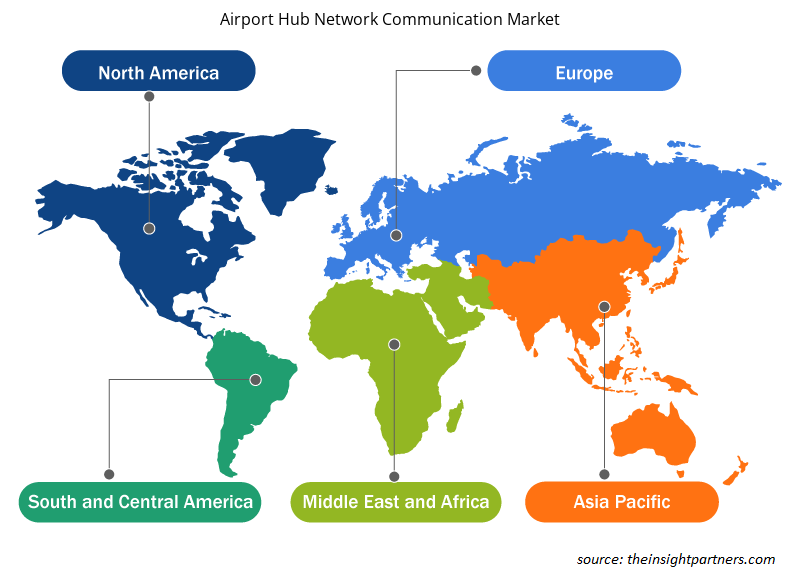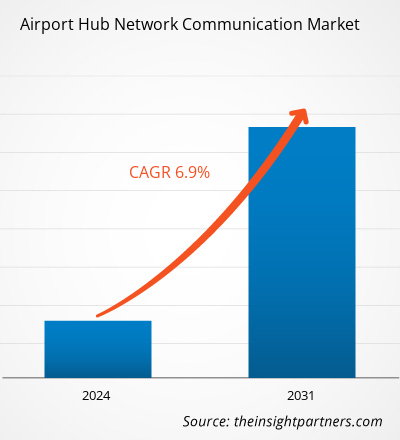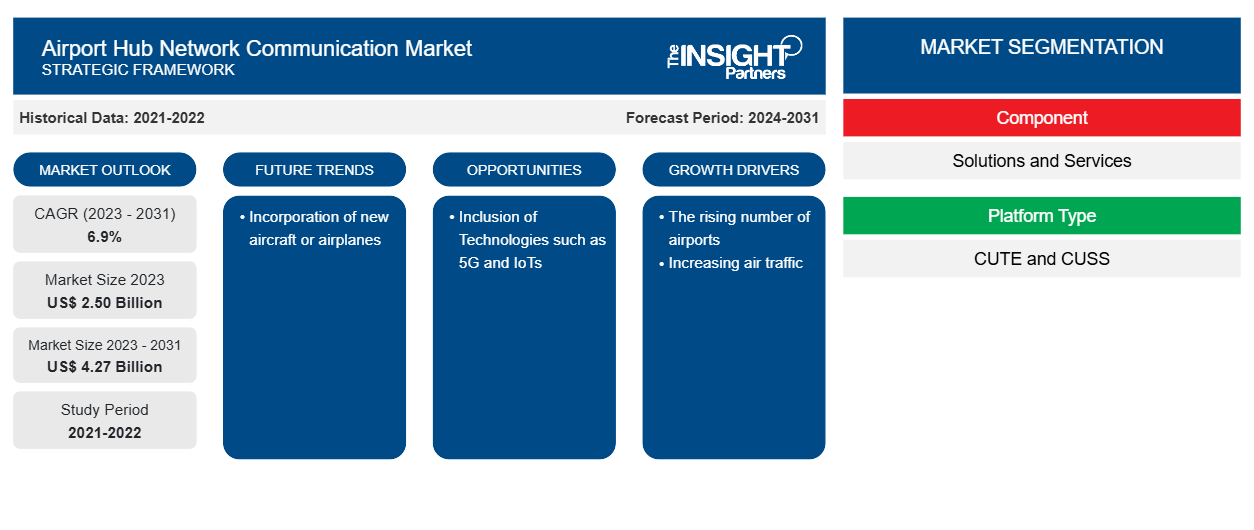Der Markt für Flughafen-Hub-Netzwerkkommunikation wird voraussichtlich von 2,50 Milliarden US-Dollar im Jahr 2023 auf 4,27 Milliarden US-Dollar im Jahr 2031 anwachsen. Der Markt wird zwischen 2023 und 2031 voraussichtlich eine durchschnittliche jährliche Wachstumsrate von 6,9 % verzeichnen. Die Einbindung neuer Flugzeuge oder Maschinen wird wahrscheinlich ein wichtiger Trend auf dem Markt bleiben.
Marktanalyse für Flughafen-Hub-Netzwerkkommunikation
Das Ökosystem des Flughafen-Hub-Netzwerkkommunikationsmarktes besteht aus Technologieentwicklern, Lösungs- und Serviceanbietern sowie Endbenutzern. Technologieanbieter bieten KI, IoT-basierte Software und entsprechende Softwareentwicklungskits an. Fluggesellschaften in der Luftfahrtbranche gehen aktiv Partnerschaften mit Technologieanbietern ein, um ein Kommunikationsnetzwerk mit Fluggesellschaften und Flughäfen aufzubauen. Lösungs- und Serviceanbieter bieten verschiedene Arten von Diensten an, wie KI, IoT-basierte Software, CUSS- und CUTE-Plattformen, Internetdienste und andere Dienste im Zusammenhang mit der Kommunikation in Fluggesellschaften und Flughäfen.
Marktübersicht für Flughafen-Hub-Netzwerkkommunikation
Die Anbieter von Kommunikationslösungen und -diensten für Flughafen-Hubs sind Schlüsselelemente des Marktes für Netzwerkkommunikation für Flughafen-Hubs. Diese Akteure sind an den meisten Aktivitäten des Marktes für Flughafen-Hub-Kommunikation beteiligt, beispielsweise an der Bereitstellung von Diensten und Lösungen für Flughäfen und Fluggesellschaften. Die wichtigsten Akteure auf dem Markt sind Honeywell International Inc, SITA Switzerland SaRl, Amazon Web Services, Collins Aerospace, Amadeus IT Group SA, Embross Systems Pvt Ltd, Materna IPS GmbH, TAV Technologies Ltd, Cisco Systems Inc. und Telefonaktiebolaget LM Ericsson. Verschiedene Luftfahrtunternehmen auf der ganzen Welt sind die Endnutzer des Marktes für Netzwerkkommunikation für Flughafen-Hubs und haben daher einen erheblichen Anteil am Marktwachstum.
Passen Sie diesen Bericht Ihren Anforderungen an
Sie erhalten kostenlose Anpassungen an jedem Bericht, einschließlich Teilen dieses Berichts oder einer Analyse auf Länderebene, eines Excel-Datenpakets sowie tolle Angebote und Rabatte für Start-ups und Universitäten.
-
Holen Sie sich die wichtigsten Markttrends aus diesem Bericht.Dieses KOSTENLOSE Beispiel umfasst eine Datenanalyse von Markttrends bis hin zu Schätzungen und Prognosen.
Markttreiber und Chancen für die Netzwerkkommunikation an Flughafen-Hubs
Zunehmender Flugverkehr
Die Urbanisierungsraten nehmen weltweit zu. Laut dem Minister für Zivilluftfahrt und Stahl wird beispielsweise die Urbanisierung Indiens voraussichtlich von 34,9 % im Jahr 2020 auf 40 % im Jahr 2030 ansteigen. Aufgrund der stärkeren Urbanisierung steigt das verfügbare Einkommen der Menschen, was zu höheren Ausgaben der Menschen geführt hat. Laut der International Air Transport Association (IATA) beispielsweise stieg der weltweite Flugverkehr im Januar 2023 im Vergleich zum Januar 2022 um 67,0 %. Darüber hinaus wuchs der Flugverkehr im Januar 2023 im Vergleich zum Januar 2019 um 84,2 %. Mehr Flugverkehr führt zu einer höheren Anzahl von Flugoperationen weltweit. Darüber hinaus steigt mit dem Anstieg des E-Commerce und des Welthandels weltweit die Nachfrage nach Lufttransporten für den Gütertransport, um den Anforderungen von Unternehmen und Verbrauchern nach schnellen Lieferungen gerecht zu werden. Darüber hinaus wird laut Boeings Commercial Market Outlook (CMO) 2022–2041 erwartet, dass der Luftfrachtverkehr zwischen 2022 und 2041 um 3,8 % wachsen wird.
Einbeziehung von Technologien wie 5G und IoTs
Laut IATA wird die Zahl der Flugreisenden bis 2037 voraussichtlich 8,2 Milliarden erreichen. Erhöhter Flugverkehr führt auch zu mehr Flügen, wobei die Kommunikation zwischen Flughafen und Fluglinienbehörden für einen effizienten Flughafenbetrieb und ein effizientes Flugmanagement unverzichtbar ist . Angesichts der steigenden Zahl an Fluggästen muss der Luftfahrtsektor umfassend gerüstet sein, um dieses erhöhte Flugaufkommen zu bewältigen. Flughäfen und Fluggesellschaften benötigen daher leistungsstarke Lösungen wie Flughafen 4.0 oder Flughafendigitalisierung, um die steigenden Passagierzahlen bewältigen zu können. IoT-Konnektivität in den Flughafen-Hubs ermöglicht es ihnen, ihre vorhandenen oder neuen Hardwaresysteme mit dem Internet zu verbinden und so zu mehr Transparenz, Konnektivität, vereinfachten Arbeitsabläufen und besserer Kommunikation zwischen den Fluggesellschaften und den Flughafenbehörden beizutragen. Verbesserte Konnektivität bietet darüber hinaus mehr Sicherheit und effizientere Arbeitsabläufe in allen Flugphasen, von der Ankunft bis zum Abflug.
Segmentierungsanalyse des Marktberichts zur Flughafen-Hub-Netzwerkkommunikation
Wichtige Segmente, die zur Ableitung der Marktanalyse für Flughafen-Hub-Netzwerkkommunikation beigetragen haben, sind Komponente, Plattformtyp, Konnektivitätstyp und Endbenutzer.
- Basierend auf den Komponenten ist der Markt für Flughafen-Hub-Netzwerkkommunikation in Lösungen und Dienste segmentiert. Das Dienstleistungssegment hatte im Jahr 2023 einen größeren Marktanteil.
- Basierend auf der Plattform ist der Markt für Flughafen-Hub-Netzwerkkommunikation in CUTE und CUSS segmentiert. Das CUTE-Segment hatte im Jahr 2023 einen größeren Marktanteil.
- Basierend auf dem Verbindungstyp ist der Markt für Flughafen-Hub-Netzwerkkommunikation in Internet und MPLS segmentiert. Das MPLS-Segment hatte im Jahr 2023 einen größeren Marktanteil.
- Basierend auf den Endnutzern ist der Markt für Flughafen-Hub-Netzwerkkommunikation in Fluggesellschaften und Flughäfen segmentiert. Das Segment Flughäfen hatte im Jahr 2023 einen größeren Marktanteil. Darüber hinaus wurde das Segment Fluggesellschaften weiter in Passagier- und Frachtverkehr unterteilt. Auch das Segment Flughäfen wurde weiter in Klasse I, Klasse II, Klasse III und Klasse IV unterteilt.
Marktanteilsanalyse für Flughafen-Hub-Netzwerkkommunikation nach geografischer Lage
Der geografische Umfang des Marktberichts zur Flughafen-Hub-Netzwerkkommunikation ist hauptsächlich in fünf Regionen unterteilt: Nordamerika, Europa, Asien-Pazifik, Naher Osten und Afrika sowie Südamerika.
Nordamerika dominierte den Markt im Jahr 2023, gefolgt von Europa und dem asiatisch-pazifischen Raum. Darüber hinaus dürfte der asiatisch-pazifische Raum in den kommenden Jahren die höchste durchschnittliche jährliche Wachstumsrate verzeichnen. Die USA hatten den größten Marktanteil am nordamerikanischen Markt für die Kommunikation von Flughafen-Hub-Netzwerken. Im Jahr 2021 gab der Airports Council International-North America an, dass US-Flughäfen bis 2026 Investitionen in Höhe von mehr als 115 Milliarden US-Dollar für ihre Entwicklung benötigen. Aufgrund der COVID-19-Pandemie wurden die Pläne zur Flughafenerweiterung jedoch unterbrochen. Das Land hat vor kurzem begonnen, nach Möglichkeiten zu suchen, sein Angebot an Luftfahrtdienstleistungen zu erweitern. Im Jahr 2022 kündigte die US-amerikanische Federal Aviation Administration (FAA) Pläne an, im Jahr 2023 im Rahmen des Infrastructure Investment and Jobs Act (IIJA) 1 Milliarde US-Dollar für flughafenbezogene Projekte über einen Zeitraum von fünf Jahren zu investieren.CAGR in the coming years. The US accounted for the largest market share in North America airport hub network communication market. In 2021, the Airports Council International-North America stated that US airports require more than US$ 115 billion of investment for their development by 2026. However, due to the COVID-19 pandemic, the airport expansion plans were disrupted. The country has recently started looking for ways to expand its range of aviation services. In 2022, the US Federal Aviation Administration (FAA) announced plans of investing US $1 billion in 2023 for airport-related projects spanning five years under the Infrastructure Investment and Jobs Act (IIJA).
Regionale Einblicke in den Markt für Flughafen-Hub-Netzwerkkommunikation
Die regionalen Trends und Faktoren, die den Markt für Flughafen-Hub-Netzwerkkommunikation während des gesamten Prognosezeitraums beeinflussen, wurden von den Analysten von Insight Partners ausführlich erläutert. In diesem Abschnitt werden auch Marktsegmente und Geografien für Flughafen-Hub-Netzwerkkommunikation in Nordamerika, Europa, im asiatisch-pazifischen Raum, im Nahen Osten und Afrika sowie in Süd- und Mittelamerika erörtert.

- Erhalten Sie regionale Daten zum Markt für Flughafen-Hub-Netzwerkkommunikation
Umfang des Marktberichts zur Flughafen-Hub-Netzwerkkommunikation
| Berichtsattribut | Details |
|---|---|
| Marktgröße im Jahr 2023 | 2,50 Milliarden US-Dollar |
| Marktgröße bis 2031 | 4,27 Milliarden US-Dollar |
| Globale CAGR (2023 - 2031) | 6,9 % |
| Historische Daten | 2021-2022 |
| Prognosezeitraum | 2024–2031 |
| Abgedeckte Segmente |
Nach Komponente
|
| Abgedeckte Regionen und Länder |
Nordamerika
|
| Marktführer und wichtige Unternehmensprofile |
|
Dichte der Marktteilnehmer für die Netzwerkkommunikation an Flughafen-Hubs: Auswirkungen auf die Geschäftsdynamik verstehen
Der Markt für Flughafen-Hub-Netzwerkkommunikation wächst rasant, angetrieben durch die steigende Endnutzernachfrage aufgrund von Faktoren wie sich entwickelnden Verbraucherpräferenzen, technologischen Fortschritten und einem größeren Bewusstsein für die Vorteile des Produkts. Mit steigender Nachfrage erweitern Unternehmen ihr Angebot, entwickeln Innovationen, um die Bedürfnisse der Verbraucher zu erfüllen, und nutzen neue Trends, was das Marktwachstum weiter ankurbelt.
Die Marktteilnehmerdichte bezieht sich auf die Verteilung der Firmen oder Unternehmen, die in einem bestimmten Markt oder einer bestimmten Branche tätig sind. Sie gibt an, wie viele Wettbewerber (Marktteilnehmer) in einem bestimmten Marktraum im Verhältnis zu seiner Größe oder seinem gesamten Marktwert präsent sind.
Die wichtigsten auf dem Markt für Flughafen-Hub-Netzwerkkommunikation tätigen Unternehmen sind:
- Honeywell International Inc
- SITA Switzerland SaRl
- Amazon Web Services Inc
- Collins Luft- und Raumfahrt
- Amadeus IT Group SA
- Embross Systems Pvt Ltd
Haftungsausschluss : Die oben aufgeführten Unternehmen sind nicht in einer bestimmten Reihenfolge aufgeführt.

- Überblick über die wichtigsten Akteure auf dem Markt für Flughafen-Hub-Netzwerkkommunikation
Nachrichten und aktuelle Entwicklungen zum Flughafen-Hub-Netzwerkkommunikationsmarkt
Der Markt für Flughafen-Hub-Netzwerkkommunikation wird durch die Erfassung qualitativer und quantitativer Daten nach Primär- und Sekundärforschung bewertet, die wichtige Unternehmensveröffentlichungen, Verbandsdaten und Datenbanken umfasst. Nachfolgend sind einige der Entwicklungen auf dem Markt für Flughafen-Hub-Netzwerkkommunikation aufgeführt:
- SITA setzt in Zusammenarbeit mit dem Reiseidentitätsunternehmen Zamna Technologies auf Innovationen mit Spitzentechnologie, um seine Lösungen für Fluggesellschaften, Flughäfen und Grenzen zu stärken. Die Lösung von Zamna verwendet ein dezentrales Blockchain-basiertes Modell, um die Überprüfung und Handhabung von Passagierdaten wie Reisepässen, Visa und Gesundheitsinformationen zu verändern und so Reisenden, Fluggesellschaften, Flughäfen und Regierungen mehr Sicherheit, Komfort und Effizienz zu bieten. (Quelle: SITA, Pressemitteilung, Januar 2023)
- Die neue Partnerschaft zwischen Etihad Cargo und SF Airlines bietet den Kunden von Etihad Cargo eine bessere Anbindung an 25 Inlandsziele in China über das Lkw-Zubringernetz von SF Airlines und erweitert damit die Kapazitäten von Etihad Cargo in der Region. (Quelle: Etihad, Pressemitteilung, Juni 2023)
Marktbericht zur Netzwerkkommunikation an Flughäfen und deren Ergebnisse
Der Bericht „Marktgröße und Prognose für Flughafen-Hub-Netzwerkkommunikation (2021–2031)“ bietet eine detaillierte Analyse des Marktes, die die folgenden Bereiche abdeckt:
- Marktgröße und Prognose für die Flughafen-Hub-Netzwerkkommunikation auf globaler, regionaler und Länderebene für alle wichtigen Marktsegmente, die im Rahmen des Berichts abgedeckt sind
- Markttrends für die Netzwerkkommunikation an Flughafenknotenpunkten sowie Marktdynamiken wie Treiber, Einschränkungen und wichtige Chancen
- Detaillierte Porter-Fünf-Kräfte-Analyse
- Marktanalyse für Flughafen-Hub-Netzwerkkommunikation mit wichtigen Markttrends, globalen und regionalen Rahmenbedingungen, wichtigen Akteuren, Vorschriften und aktuellen Marktentwicklungen
- Branchenlandschaft und Wettbewerbsanalyse, die die Marktkonzentration, Heatmap-Analyse, prominente Akteure und aktuelle Entwicklungen für den Markt für Flughafen-Hub-Netzwerkkommunikation umfasst
- Detaillierte Firmenprofile
- Historische Analyse (2 Jahre), Basisjahr, Prognose (7 Jahre) mit CAGR
- PEST- und SWOT-Analyse
- Marktgröße Wert/Volumen – Global, Regional, Land
- Branchen- und Wettbewerbslandschaft
- Excel-Datensatz
Aktuelle Berichte
Erfahrungsberichte
Grund zum Kauf
- Fundierte Entscheidungsfindung
- Marktdynamik verstehen
- Wettbewerbsanalyse
- Kundeneinblicke
- Marktprognosen
- Risikominimierung
- Strategische Planung
- Investitionsbegründung
- Identifizierung neuer Märkte
- Verbesserung von Marketingstrategien
- Steigerung der Betriebseffizienz
- Anpassung an regulatorische Trends























 Kostenlose Probe anfordern für - Markt für Flughafen-Hub-Netzwerkkommunikation
Kostenlose Probe anfordern für - Markt für Flughafen-Hub-Netzwerkkommunikation